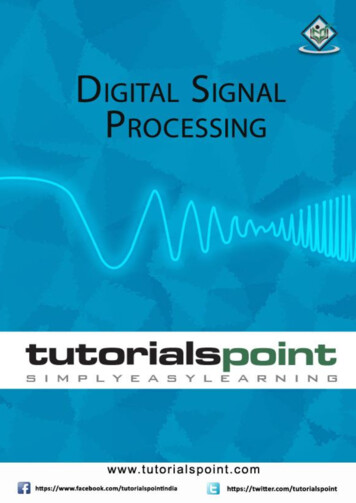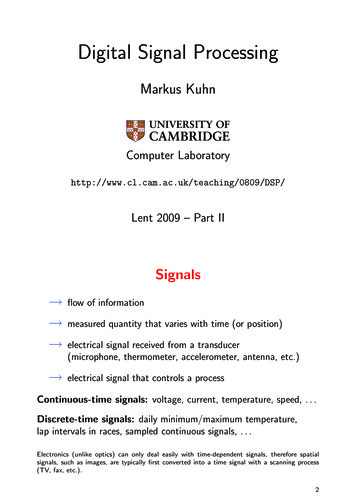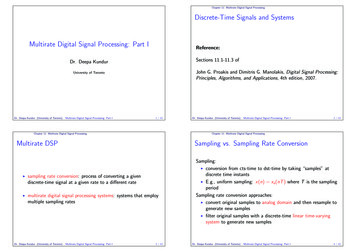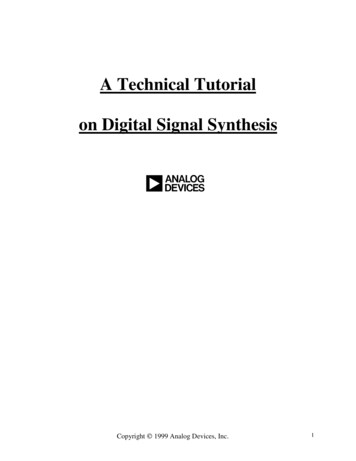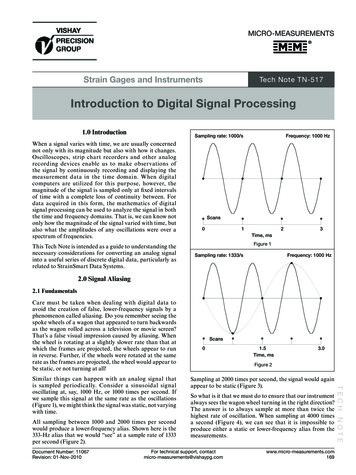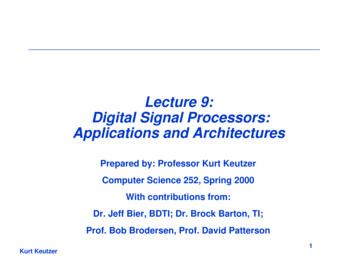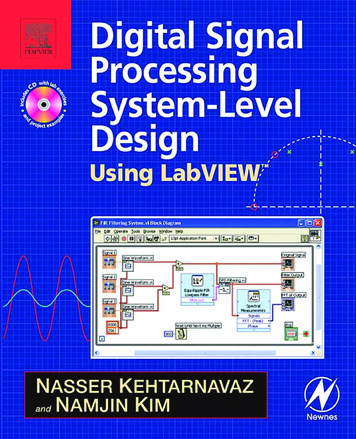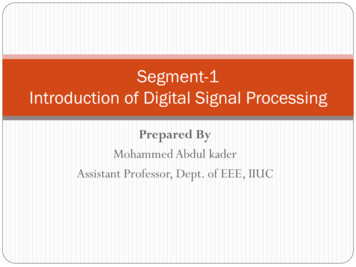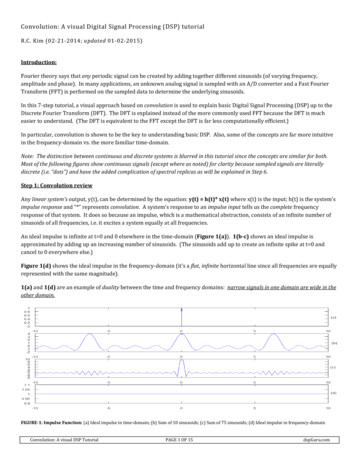
Transcription
Convolution: A visual Digital Signal Processing (DSP) tutorialR.C. Kim (02-21-2014; updated 01-02-2015)Introduction:Fourier theory says that any periodic signal can be created by adding together different sinusoids (of varying frequency,amplitude and phase). In many applications, an unknown analog signal is sampled with an A/D converter and a Fast FourierTransform (FFT) is performed on the sampled data to determine the underlying sinusoids.In this 7-step tutorial, a visual approach based on convolution is used to explain basic Digital Signal Processing (DSP) up to theDiscrete Fourier Transform (DFT). The DFT is explained instead of the more commonly used FFT because the DFT is mucheasier to understand. (The DFT is equivalent to the FFT except the DFT is far less computationally efficient.)In particular, convolution is shown to be the key to understanding basic DSP. Also, some of the concepts are far more intuitivein the frequency-domain vs. the more familiar time-domain.Note: The distinction between continuous and discrete systems is blurred in this tutorial since the concepts are similar for both.Most of the following figures show continuous signals (except where as noted) for clarity because sampled signals are literallydiscrete (i.e. “dots”) and have the added complication of spectral replicas as will be explained in Step 6.Step 1: Convolution reviewAny linear system’s output, y(t), can be determined by the equation: y(t) h(t)* x(t) where x(t) is the input; h(t) is the system’simpulse response and “*” represents convolution. A system’s response to an impulse input tells us the complete frequencyresponse of that system. It does so because an impulse, which is a mathematical abstraction, consists of an infinite number ofsinusoids of all frequencies, i.e. it excites a system equally at all frequencies.An ideal impulse is infinite at t 0 and 0 elsewhere in the time-domain (Figure 1(a)). 1(b-c) shows an ideal impulse isapproximated by adding up an increasing number of sinusoids. (The sinusoids add up to create an infinite spike at t 0 andcancel to 0 everywhere else.)Figure 1(d) shows the ideal impulse in the frequency-domain (it’s a flat, infinite horizontal line since all frequencies are equallyrepresented with the same magnitude).1(a) and 1(d) are an example of duality between the time and frequency domains: narrow signals in one domain are wide in theother domain.FIGURE-1: Impulse Function: (a) Ideal impulse in time-domain; (b) Sum of 10 sinusoids; (c) Sum of 75 sinusoids; (d) Ideal impulse in frequency-domainConvolution: A visual DSP TutorialPAGE 1 OF 15dspGuru.com
For discrete systems, an impulse is 1 (not infinite) at n 0 where n is the sample number, and the discrete convolution equationis y[n] h[n]*x[n].The key idea of discrete convolution is that any digital input, x[n], can be broken up into a series of scaled impulses. For discretelinear systems, the output, y[n], therefore consists of the sum of scaled and shifted impulse responses, i.e. convolution of x[n] withh[n].Figure 2(a-f) is an example of discrete convolution. (Don’t worry if you don’t understand it yet- it should be clearer after Step4.)FIGURE-2: Discrete Convolution example: (a) x[n] input; (b) h[n] impulse response (c-e) shifted impulse responses; (f) y[n] sum of c-eIt can be proven (but it won’t here) that convolution in the time-domain is equivalent to multiplication in the frequency-domainand vice-versa: x[n] * h [n] - X[f]· H[f]1.Likewise, convolution in the frequency-domain is equivalent to multiplication in the time-domain and vice-versa:x[n] · h[n] - X[f] * H[f].Step 2: SinusoidsSinusoids are important because any periodic signal can be written as the sum of sinusoids. If you understand how DSP workswith sinusoids, then you can easily extend that understanding to any linear signal.1 X[f] and H[f] are the frequency-domain versions of x[n] and h[n].Convolution: A visual DSP TutorialPAGE 2 OF 15dspGuru.com
We start by looking at the Sine and Cosine functions in the familiar time-domain (Figure 3(a)). They’re the same except thatCosine is 90 ( π/2 radians) ahead of Sine.FIGURE-3: Cosine (green) vs. Sine (red) @ 1 MHz: (a) time-domain; (b) frequency-domainSine is an odd function because it’s not symmetric at t 0 (sin t -sin (-t)). Cosine is an even function since it’s symmetric at t 0(cos t cos (-t)). Cosine is non-zero at 0- this means that any DC value (constant offset) in a signal is due solely to its cosinecomponent(s) since sine is 0.Now look at Figure 3(b), which shows the frequency-domain representation of sine and cosine. The derivation of these Fouriertransforms (FT) won’t be shown- however, it’s still possible to develop an intuitive feel for the frequency-domainrepresentation.Convolution: A visual DSP TutorialPAGE 3 OF 15dspGuru.com
A sinusoid consists of one frequency, so it should be a single line in the frequency-domain. Two lines are shown (one positiveand one negative) because two directions are possible. We saw that cosine is an even function in the time-domain and the samesymmetry is seen in the frequency-domain. Sine is an odd function and the asymmetry is also seen in the frequency-domain, i.e.sin f -sin (-f). In the time-domain, cosine is 90 ahead and we see the 90 phase difference in the frequency-domain as well.Negative frequency will become clearer in Step 3.Step 3: Complex numbersNow we introduce the famous Euler equation: e jωt cos ωt jsin ωt where ω 2πf.By rearranging terms, the following equations also shown in Figure 3(b) can be derived:Cos ωt ½ · (e-jωt ejωt)Sin ωt ½ · (e-(jωt-π/2) e(jωt -π/2)) ½ · (e-jωt · e π/2 ejωt · e-π/2) ½ · (je-jωt - jejωt)Again, the full derivations won’t be shown here- however, using these equations is actually straightforward.First of all, j simply represents a 90 phase-shift (rotation) without any change in frequency or magnitude. (j -1, so ifmultiplication by -1 causes 180 rotation, then half of that is 90 .)A more formal definition is to expand the Euler equation to include a phase offset ф: ej(ωt ф) cos(ωt ф) jsin(ωt ф). If ω 0and ф π/2 (90 ), then ejπ/2 cos π/2 jsin π/2 0 j(1) j.In Figure 4, Sine has been rotated by 90 , and is plotted next to cosine. The 3-d sum is a rotating spiral in the time-domain. IfSine is positive, the spiral rotates in the counter clockwise (CCW) direction. If Sine is negative, the spiral rotates in the clockwise (CW) direction (that’s all there is to negative frequency.) The speed of rotation (number of complete circles per second) issimply the frequency.FIGURE-4: Complex-number in the time-domainConvolution: A visual DSP TutorialPAGE 4 OF 15dspGuru.com
In Figure 5(a-c), we look at the frequency-domain version of a complex number. If we rotate Sine by 90 , then it looks like5(b). If we then add cos A jsin A, one of the lines cancels out, and we’re left with a single side-band (SSB) vector shown in5(c). This single vector is static, i.e. it does not rotate or move at all.Figure-5: Complex number in the frequency-domain (MHz): (a) cos A and sin A; (b-c) cos A jsin ANote: For cos A - j·sin A, the SSB vector would be at f –A.Convolution: A visual DSP TutorialPAGE 5 OF 15dspGuru.com
Figure-6: Polar formFigure 6 shows the polar form, which is obtained from a side-view of either Figure 4 or 5(c).For the polar form, it’s common to use the notation: R ф where R (I2 Q2) and ф phase. I is the real (in-phase) componentand Q is the imaginary (quadrature-phase) component as shown in Figure 62.In the time-domain, the polar form is like a rotating clock hand (ф ωt a phase-constant).In the frequency-domain, the polar form is like a broken clock- the clock hand does not move (ф a phase-constant).Step 4: Convolution with SinusoidsMost of the time, convolution is thought of only in terms of a system’s output as shown in Step 1. However, it’s actually amathematical operation in its own right as shown next.Convolution is complicated and requires calculus when both operands are continuous waveforms. But when one of theoperands is an impulse (delta) function, then it can be easily done by inspection.The rules of discrete convolution are (not necessarily performed in this order):1) Shift either signal by the other (convolution is commutative).2)Multiply the magnitudes (and add any overlapping lines).3) Add the phases.2 I/Q are always perpendicular to each other regardless of ф. For a single complex number, any phase-offset can be set to 0 since the axis-orientation is arbitrary. Phase really only matters when plotting multiple complex numbers, which can have any phase-offset with respect toeach other.Note: I/Q have the form: i[n] jq[n] in the time-domain; and I[f] jQ[f] in the frequency-domain.Convolution: A visual DSP TutorialPAGE 6 OF 15dspGuru.com
Cosine-Cosine example:A simple example is the well-known trig identity: cos A · cos B ½·cos (A B) ½·cos (A-B).Figure 7(a-c) shows the equivalent operation in the frequency-domain. As explained in Step 1, multiplication in the timedomain is convolution in the frequency-domain. Convolution is performed by “lifting” the function in 7(a), which is centeredat f 0, and shifting the center to both f -2 and f 2 (7(b)). After multiplying the magnitudes (1/2· 1/2 1/4), the result in 7(c)agrees with the trig identity. In this case, the phases are both 0 so rule #3 is N/A.Figure 7(d-f) shows the case when A B. The two “overlapping” lines at f 0 add up to create a DC value (1/4 1/4 ½).FIGURE-7: Cosine-Cosine convolution in the frequency-domain (real-axis only): (a-c) for different f; (d-f) for the same fJ-example:The 3rd rule of convolution is that phases add. Multiplying by j in the time-domain is convolution in the frequency-domain.Since j’s magnitude is 1 and f 0, the only effect is rotation by 90 (or -90 with –j) without any frequency-shift.Figure 8(a) show a complex number at f 1 (1 0 in polar notation) and j (1 90 ) at f 0. After multiplication with j, thecomplex number is rotated to 1 90 in 8(b). 8(c) shows a 2nd shift back to the real (negative) axis (1 90 · 1 90 1 180 )after multiplying by j again.Multiplying by j twice more (not shown) would result in 1 180 · 1 90 1 270 ; and then 1 270 · 1 90 1 360 1 0 .Convolution: A visual DSP TutorialPAGE 7 OF 15dspGuru.com
Figure-8: J-Convolution in the frequency-domain: (a) complex number at 1 0 ; (b) complex number at 1 90 ; (c) complex number at 1 180 Convolution: A visual DSP TutorialPAGE 8 OF 15dspGuru.com
Sine-Sine example:Figure 9(a-d) shows the case for sin A · sin B ½·cos (A-B) - ½·cos (A B).9 (e-h) shows the case for sin A · sin A. Like 7(f), the final result includes a non-zero value at f 0 (DC).In 9(d) and 9(h), 9(c) and 9(g) are rotated respectively to the real-axis per rule #3 (90 90 180 like 8(c)).Note: Other trig identities can be shown as well. E.g. adding Figures 7(f) and 9(h) shows that sin2 A cos2 A 1.Figure-9: Sine-Sine convolution in the frequency-domain: (a-d) for different f; (e-h) for the same fCosine-Sine example:Figure 10(a-d) shows the case for cos A · sin A ½·sin (A A) ½·sin (A-A). 10(e-h) shows the case for cos A · (-sin A).In 10(c-d) and 10(g-h), the result has been rotated to the j-axis per rule #3 (0 90 90 like 8(b)).In 10(d) and 10(h), there’s no DC value at f 0 even though both sinusoids have the same frequency because it cancels out to 0.Convolution: A visual DSP TutorialPAGE 9 OF 15dspGuru.com
Figure-10: Cosine-Sine convolution in the frequency-domain: (a-d) same f with Sine; (e-h) same f with -SineKey point: If two sinusoids are multiplied in the time-domain (convolution in the frequency-domain), a non-zero value at DC(f 0) only occurs when the sinusoids have the same frequency and their phase offset is not 90 . If the frequencies match, theDC value is max when the phase offset is 0 (cos A · cos A) and min (0) when the phase offset is 90 (cos A · sin A). The DC valuedue to a frequency match is the basis for the DFT.The time-domain equivalent is that the average of a sinusoid over integer multiples of a full period is 0 because it has equalpositive and negative area. When two sinusoids are multiplied, the time-domain average is still 0 unless the aforementionedconditions are met.Step 5: Convolution with Complex NumbersIn Step 4, it was shown that multiplying/convolving two Cosines (with the same frequency) or two Sines (with the samefrequency) results in a DC value. For simplicity, Figures 7-10 showed 0/90 phase offsets. For other phases, the DC value isdivided between the real and imaginary axes per the I/Q equations in Figure 6.Now, we show how to recover the full magnitude regardless of the phase-offset.Up front, the answer is simply ejωt · e-jωt e0 1. This equation is the key to understanding the DFT (as well as frequencytranslation for up/down-conversion).Since e jωt cos ωt jsin ωt, the above equation can be written as (I jQ) · (cos A – j ·sin A), if we substitute A ωt and I jQ cosA jsin A. This works out to IDC jQDC (I·cos A Q·sin A) j(Q·cos A - I·sin A). Remember that j2 -1 and –j2 1.Figure 11(a-f) shows the equivalent convolution in the frequency-domain. When we sum up the lines we get a DC value (withfull magnitude 1, not just 1/2) at f 0 and nothing else.We already showed these cases in Figures 7-10, so Figure 11 just sums up the results: 11(a-c) I·cos A Q·sin A; 11(d-f) Q·cos A - I·sin A. 11(f), which is 0 in this case, is flipped to the real-axis due to multiplication by j.Convolution: A visual DSP TutorialPAGE 10 OF 15dspGuru.com
Figure-11: Complex-number convolution: (a) from 7(f) (b) from 9(h) (c); (d) from 10(d) (e) from 10(h) (f); (g) * (h) (i) 11(c/f)This is a lot of work, which is unnecessary, if you just convolve the SSB complex numbers instead as shown in 11(g-i).So far, we’ve been looking at cases with 0/90 phase offsets. But this works regardless of phase. Th
In this 7-step tutorial, a visual approach based on convolution is used to explain basic Digital Signal Processing (DSP) up to the Discrete Fourier Transform (DFT). The DFT is explained instead of the more commonly used FFT because the DFT is muchFile Size: 450KBPage Count: 15

